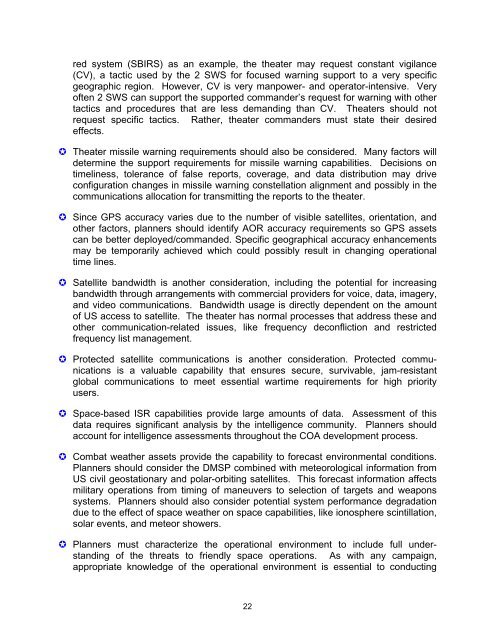Space Operations
Space Operations
Space Operations
Create successful ePaper yourself
Turn your PDF publications into a flip-book with our unique Google optimized e-Paper software.
ed system (SBIRS) as an example, the theater may request constant vigilance<br />
(CV), a tactic used by the 2 SWS for focused warning support to a very specific<br />
geographic region. However, CV is very manpower- and operator-intensive. Very<br />
often 2 SWS can support the supported commander’s request for warning with other<br />
tactics and procedures that are less demanding than CV. Theaters should not<br />
request specific tactics. Rather, theater commanders must state their desired<br />
effects.<br />
Theater missile warning requirements should also be considered. Many factors will<br />
determine the support requirements for missile warning capabilities. Decisions on<br />
timeliness, tolerance of false reports, coverage, and data distribution may drive<br />
configuration changes in missile warning constellation alignment and possibly in the<br />
communications allocation for transmitting the reports to the theater.<br />
Since GPS accuracy varies due to the number of visible satellites, orientation, and<br />
other factors, planners should identify AOR accuracy requirements so GPS assets<br />
can be better deployed/commanded. Specific geographical accuracy enhancements<br />
may be temporarily achieved which could possibly result in changing operational<br />
time lines.<br />
Satellite bandwidth is another consideration, including the potential for increasing<br />
bandwidth through arrangements with commercial providers for voice, data, imagery,<br />
and video communications. Bandwidth usage is directly dependent on the amount<br />
of US access to satellite. The theater has normal processes that address these and<br />
other communication-related issues, like frequency deconfliction and restricted<br />
frequency list management.<br />
Protected satellite communications is another consideration. Protected communications<br />
is a valuable capability that ensures secure, survivable, jam-resistant<br />
global communications to meet essential wartime requirements for high priority<br />
users.<br />
<strong>Space</strong>-based ISR capabilities provide large amounts of data. Assessment of this<br />
data requires significant analysis by the intelligence community. Planners should<br />
account for intelligence assessments throughout the COA development process.<br />
Combat weather assets provide the capability to forecast environmental conditions.<br />
Planners should consider the DMSP combined with meteorological information from<br />
US civil geostationary and polar-orbiting satellites. This forecast information affects<br />
military operations from timing of maneuvers to selection of targets and weapons<br />
systems. Planners should also consider potential system performance degradation<br />
due to the effect of space weather on space capabilities, like ionosphere scintillation,<br />
solar events, and meteor showers.<br />
Planners must characterize the operational environment to include full understanding<br />
of the threats to friendly space operations. As with any campaign,<br />
appropriate knowledge of the operational environment is essential to conducting<br />
22
















